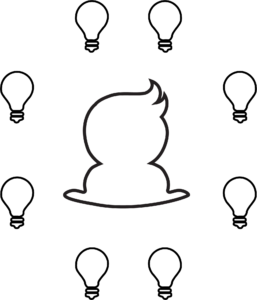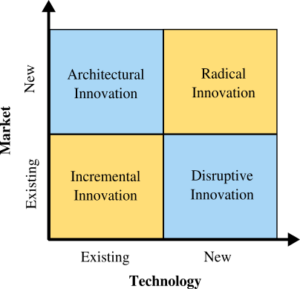A new way to understand the types of innovation

Written by Anderson Niu
August 1st, 2020

What is innovation for you?
It is a hard word to conceptualize, isn’t it?
But why is it so hard?
Innovation is a very broad concept that involves creativity and abstract results. Consequently, it opens room for different interpretations and perspectives.
Many individuals around the world publish their studies on innovation, and all of the theories and researches out there, although very different from each other, make sense somehow because they focus on different aspects of innovation.
For instance, the partners at Doblin – a global innovation firm, in their book “10 types of innovation”, separate corporate innovation into 10 different types and show how to manage each one of them. Pretty interesting and worth to have a look at. click here
Greg Satell brings an interesting approach to explain innovation in his article for the HBR website. He explores 2 dimensions: how well we define the problem; and how well we define the domain. Based on those questions, he brings up 4 different types of innovation. If you want to know more about this approach, click here
Another interesting approach is The “Oslo Manual for measuring innovation”, which introduces a simpler analysis regarding 4 types of innovation, but considering the big picture of possible scenarios. If you want to know more about this approach, click here.
I developed a theory to support all of these studies about innovation and summarize them into what I call the Innovation SPOT matrix. It tackles the concepts of innovation by focusing on the object of the change instead of classifying the possible outcomes they can generate. Let me introduce the basic concepts first in categories:
THE 4 INNOVATION CATEGORIES
I bring here my vision on how to explain innovation considering other theories already published. There are 4 categories that I consider for innovation – Service, Product, Organization, and Technique.
 Service
Service
It represents every outcome that involves interaction with a provider or a system. However, it is not only for customer engagement. Inside an organization, employees also provide a service to the company.
 Product
Product
It regards both material products and intangible outcomes, such as a software developed to attend a specific need. In other words, it represents every outcome that an individual or a group can be give and/or use.
 Organization
Organization
This type concerns systems and their management, dictating the rules, the steps, and the boundaries. It involves intangible values that define the foundation of a group or system, and it usually relates to business models.
Technique
Regards the methods used to take actions of any kind. In fact, It is not limited to corporate environment, involving a personal level as well. This type of innovation is not essentially about profitable activities. It can also include hobbies and discoveries, such as creating a new dance style or a new method of memorization.
THE 4 CHANGE FACTORS
I found in my studies 4 intrinsic factors within the innovation process that represent the type of change. They are the 4 change factors:
 Structure / Foundation: This factor regards changes on the core attributes that define the object of change.
Structure / Foundation: This factor regards changes on the core attributes that define the object of change.
 Process / Functionality: A change on a product or on the steps of a process, indicating what can be done with it and how does it function.
Process / Functionality: A change on a product or on the steps of a process, indicating what can be done with it and how does it function.
 Offer / Marketing: This factor concerns changes on how the categories are promoted and monetized.
Offer / Marketing: This factor concerns changes on how the categories are promoted and monetized.
Technique / Applicability: Represents ways to use, apply, and deliver any one of the 4 categories; deal with people; and manage situations.
I created the following matrix to make it clear and simple for you to study, learn, and remember this new way to understand the innovation types. I call it the SPOT matrix.
The SPOT matrix displays the types of innovations, focusing on the object of the change in the innovation process, by matching the categories with different ways to change them.
Now, let’s focus on the outcomes of these changes with the 4 types of innovation:
THE 4 TYPES OF INNOVATION
I believe that it is possible to analyze innovation in many different dimensions, and most of them make sense if you adopt an holistic approach to seek opportunities. This analysis considers the dimensions of market and technology, where the outcomes define the type of innovation:

1) Incremental Innovation
Represents the optimization and further development of, at least, one of the four innovation categories described above, in order to increase the value perception within an existing market. It is also the most common type of innovation among companies, and usually represents the product category.
2) Disruptive Innovation
Clayton Christensen introduced this concept in his book “The Innovator’s Dilemma”. It involves applying a new technology or system on an existing market.
It tends to be a slow process once new technologies are sometimes hard to understand, to master, or to be accepted by organizations or groups. However, once the new method or technology is settled, it gradually creates new demands for the sector, shapes new markets and replaces existing services or products.
3) Architectural Innovation
Whenever somebody proves that one of the 4 innovation categories can be inserted in a different environment, or used for an unusual purpose rather than its primary one, that is called architectural innovation.
In other words, it is an adaptability of a known technology or technique, to explore a different market and establish new competition standards.
4) Radical innovation
This is the most cliché concept of innovation that exists: something never seen before that blows people’s minds and breaks rules, such as hologram phone calls, high techs shown in movies, or floating cars.
It is called “radical” because it breaks paradigms and generates a new value chain that reaches more than just the users. It can even affect the whole industry and create new markets.
It is essentially a change that revolutionizes the market, in one or all of the 4 innovation categories, and changes the way they are perceived by the population and the market.
Conclusion
The goal of this article is to show you a simpler way to analyze innovation, covering, respectively, approaches that focus on:
- The main object of the change (The 4 Innovation Categories)
- Different aspects of change (The 4 Change Factors)
- Outcomes they can produce (The 4 Types of Innovation)
It will help to illustrate the various ways that companies can innovate and where to focus their strategy in order to achieve a competitive advantage through innovation.
Hey, did you find this article useful?
Tell us here in the comments what you think about it and share with your innovator friends.


